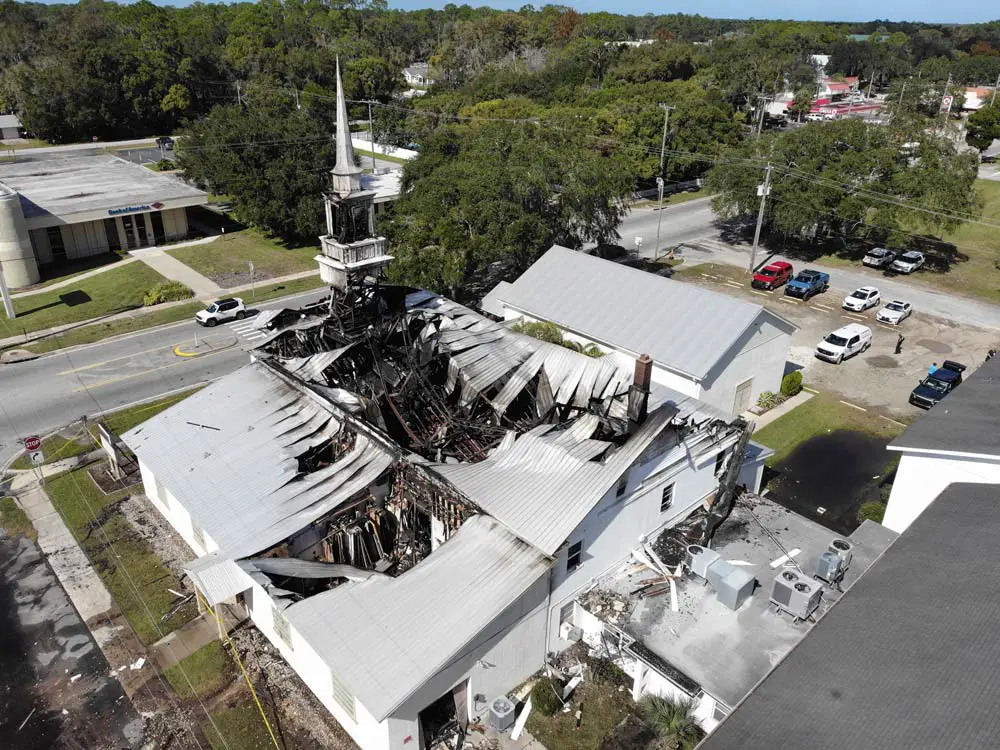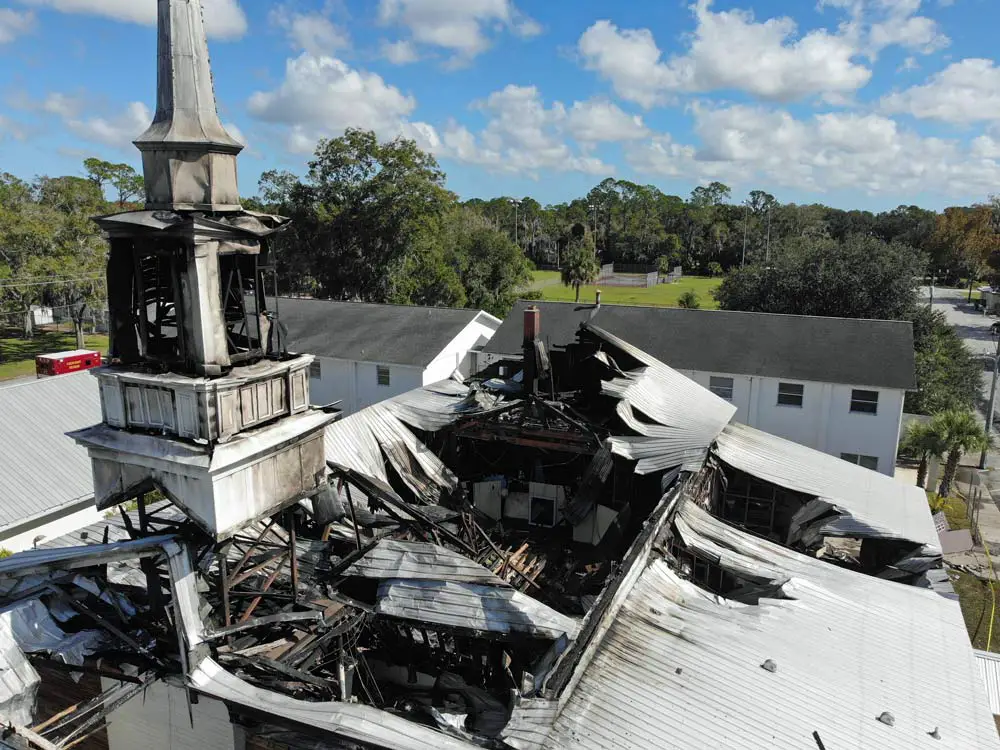
Certainly on a far smaller and architecturally less consequential scale, perhaps less on a spiritual scale as well, though no theater is ever quite devoid of the divine, but the drone footage Flagler County released of the devastation of the fire that consumed the Flagler Playhouse for half a dozen hours the night of Sunday into Monday morning cannot fail to evoke that familiar feeling, as when Notre Dame was gutted by fire in 2019, when a city’s defining landmark is as if bombed out, and its decades of history wiped out.
Flagler County Fire Chief Michael Tucker this morning said the cause was likely electrical.
“We’re certain it started at the rear of the main theater, we don’t know exactly” where, Tucker said, but that’s being narrowed down between the county’s and state fire marshal investigations. “We still don’t know what the cause was. What I caution people on is we may never know the exact cause.” But with interviews of the property owners, understanding what was being stored there and other factos, the cause will be narrowed down. “We’re starting to feel pretty certain that it was electrical in nature.”
Notre Dame survived, its medieval stone and creepy Gothic gargoyles too stubborn, too God-defying, tolet even hellfire demolish it. Bunnell’s Playhouse isn’t so lucky.
The footage in one 30-second clips shows annihilating damage you cannot see from street level, with the entirety of the theater–the main building–as if systematically bombed through its nave. The multilayered roof of metal, asphalt shingles and wood has collapsed, melted from within. The iconic spire somehow kept standing at the front of the building, held up by metal trusses, though it’s a matter of time before it is removed.
“They have already tagged the building as unsafe and so at this point the insurance as well as an engineers would have to get in. The insurance is going to have a lot to talk about,” Bunnell City Manager Alvin Jackson said this morning, referring to his building official. In other words, the building has been condemned. As for the spire, “they think that it’s not going to come tumbling down, but it will need to be addressed immediately,” by which Jackson meant it had to be removed.
A brick chimney still stands at the south end of the building like a minor echo of the spire, though it looks no less precarious. It isn’t clear from the footage to what extent the cinder block walls of the structure have been compromised. Initial reports suggested that the theater’s props may have been saved. Footage suggests that that may not be the case, as the addition alongside the west side of the theater, which contains some of the props, was also destroyed.
“They will definitely need to develop a demolition plan,” Jackson said of the Playhouse, or determine what of the compound may be salvaged. “So they will work closely with our building officials to come to those decisions.”
Two of the compounds’ four buildings were not damaged, including the Playhouse offices, and two spaces the Playhouse rents–one to artist JJ Graham.
Old Moody Boulevard has reopened to traffic in both directions, and the private school next door, in the old courthouse–if any building in downtown Bunnell would have been prone to freak combustion, that was it–resumed operations today, after it remained closed at the city manager’s suggestion on Monday. More than 2,000 customers initially lost power during the fire, when Florida Power and Light cut off electricity for safety reasons, but the overwhelming majority got their power restored quickly, while a few dozen closer to the fire zone were without it Monday morning.
The drone team’s work included numerous thermal-imaging pictures taken during the fire, and showing the surface temperature of the building at the time each picture was taken. The purpose of the imaging during the fire was to give firefighters a sense of whether the fire was still active or not, and where, since often flames or smoldering would be invisible beneath structures.
There were times during the fire when the initial picture would show 64 degrees at the surface, reflecting the water being dumped on the fire. The firefighters would stop dousing the building. Then the temperature would ump to 100, or 150 very quickly. “That was an obvious sign of a fire underneath,” said Emergency Management Director Jonathan Lord, who was at the scene of the fire (and who woke up the drone pilot to get out there that night). “If that temperature stays down or doesn’t go much above the air temperature, then you know the odds of the fire underneath is extinguished.”
The Sheriff’s Office also flew a drone in the early part of the fire.
“The drones give you a feeling of what the temperatures are, they’re not 100 percent accurate,” Tucker, the fire chief, said, but the temperature changes can allow firefighters to judge where the fire is moving.
Bunnell is working with the Playhouse to encourage its rebuilding in the city. “It was a very important part of our culture corridor not only from a historic standpoint but from cultural arts and activities and events,” Jackson said. “So we’re going to work with them to rebuild. We want it to happen. The mayor and vice mayor are committed to doing that.”
Here are the drone team’s clips, and additional drone pictures.
![]()



































TREEMAN says
Looks like a “Back-Draft” Explosion!! I can NOT see any place where the roof was vented! A slow burning fire would use the O2 in a closed building but with O2 rushing in front door, a “FIRE EXPLOSION”(aka Back-Draft) could have happened! That is why the building looks like it was “BOMBED”? Many questions for the FL Fire Marshall to investigate!
Anonymous says
This is wildly inaccurate. What you see is very typical of structural collapse after direct flame exposure…you watch too many movies.
Lance Carroll says
I’m guessing lots of fat pine was used in original construction. That stuff burns like dynamite….
Walter Fufidio says
Enjoyed many plays there. Always very spirited performances. The place will be missed.